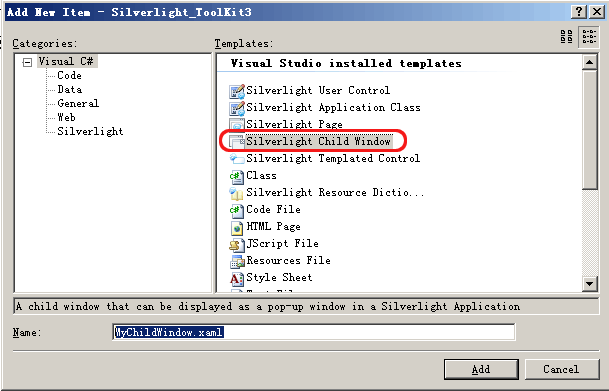ChildWindow -父窗体交互
原文链接:http://www.cnblogs.com/daizhj/archive/2009/07/23/1529323.html
在Silverlight中写一个弹窗功能并不难,但必定也要自己写代码,定义模式去实现,而
在SilverlightToolKit3中,提供了一个叫“ChildWindow”的类,位于:
使用它,我们可以很容易的将任何想放在新窗口中显示的内容,以弹窗的形式显示显示。
下面演示一下效果:
1.点击弹窗按钮。
2.弹出子窗体,并输入数据。
3.点击“提交”按钮返回父窗体。

下面就简要介绍一下其用法,如果之前我们执行了Silverlight ToolKit 3 的安装包。我
们只要在相应的SL应用项目上击鼠标右键,选“添加”--> "新建项",就可以在弹出窗口中
看到新加了一个“Silverlight Child Window”模板,这时我们选中它,并将新创建的子窗口
命名为:MyChildWindow.xaml

这样,我们在可以在这个新建的XAML文件中加入任何我们想弹窗显示的元素了,比如:
 代码
代码
<
controls:ChildWindow x:Class
=
"
Silverlight_ToolKit3.MyChildWindow
"
xmlns
=
"
http://schemas.microsoft.com/winfx/2006/xaml/presentation
"
xmlns:x
=
"
http://schemas.microsoft.com/winfx/2006/xaml
"
xmlns:controls
=
"
clr-namespace:System.Windows.Controls;assembly=System.Windows.Controls
"
Width
=
"
400
"
Height
=
"
180
"
>
<
Grid x:Name
=
"
LayoutRoot
"
Background
=
"
White
"
>
<
Grid.ColumnDefinitions
>
<
ColumnDefinition Width
=
"
100
"
/>
<
ColumnDefinition Width
=
"
300
"
/>
</
Grid.ColumnDefinitions
>
<
Grid.RowDefinitions
>
<
RowDefinition Height
=
"
50
"
/>
<
RowDefinition Height
=
"
50
"
/>
<
RowDefinition Height
=
"
50
"
/>
</
Grid.RowDefinitions
>
<
TextBlock Text
=
"
用户名:
"
Grid.Column
=
"
0
"
Grid.Row
=
"
0
"
/>
<
TextBox Width
=
"
200
"
x:Name
=
"
UserName
"
Grid.Column
=
"
1
"
Grid.Row
=
"
0
"
Height
=
"
30
"
/>
<
TextBlock Text
=
"
密码:
"
Grid.Column
=
"
0
"
Grid.Row
=
"
1
"
/>
<
TextBox Width
=
"
200
"
x:Name
=
"
PassWord
"
Grid.Column
=
"
1
"
Grid.Row
=
"
1
"
Height
=
"
30
"
/>
<
StackPanel Grid.ColumnSpan
=
"
2
"
Orientation
=
"
Horizontal
"
HorizontalAlignment
=
"
Center
"
Grid.Row
=
"
2
"
>
<
Button Content
=
"
提交
"
Width
=
"
75
"
Height
=
"
25
"
x:Name
=
"
Submit
"
Click
=
"
Submit_Click
"
/>
<
Button Content
=
"
取消
"
Width
=
"
75
"
Height
=
"
25
"
x:Name
=
"
Cancel
"
Click
=
"
Cancel_Click
"
/>
</
StackPanel
>
</
Grid
>
</
controls:ChildWindow
>
我们看到上面的XAML中的按钮有两个单击事件,分别对应提交和取消操作,相应事件处理
代码如下:
private
void
Submit_Click(
object
sender, RoutedEventArgs e)
{
this
.DialogResult
=
true
;
}
private
void
Cancel_Click(
object
sender, RoutedEventArgs e)
{
this
.DialogResult
=
false
;
}
代码比较简单,主要是将当前对话框的结果(关闭时状态)传递给父窗口。
下面我们就来看一下父窗口是如果实现弹窗功能的。
首先我们在父窗口放置一个Button元素,并将Click事件进行绑定如下:
<
Button Content
=
"
显示子窗口
"
Height
=
"
23
"
Grid.Column
=
"
0
"
Grid.Row
=
"
0
"
Click
=
"
ShowWindow_Click
"
/>
然后向父窗口的XAML.CS文件中复制如下代码:
 代码
代码
MyChildWindow myChildWindow
=
new
MyChildWindow();
public
MainPage()
{
InitializeComponent();
//
子窗口事件绑定
myChildWindow.Closed
+=
new
EventHandler(myChildWindow_Closed);
}
#region
子窗口事件代码
void
myChildWindow_Closed(
object
sender, EventArgs e)
{
if
(myChildWindow.DialogResult
==
true
)
Message.Text
=
string
.Format(
"
用户名:{0} 密码:{1}
"
, myChildWindow.UserName.Text, myChildWindow.PassWord.Text);
else
Message.Text
=
"
取消
"
;
}
private
void
ShowWindow_Click(
object
sender, RoutedEventArgs e)
{
myChildWindow.Title
=
"
子窗口信息
"
;
myChildWindow.OverlayBrush
=
new
SolidColorBrush(Colors.Yellow);
myChildWindow.Opacity
=
0.9
;
myChildWindow.HasCloseButton
=
true
;
myChildWindow.Foreground
=
new
SolidColorBrush(Colors.Red);
myChildWindow.FontSize
=
14
;
//
myChildWindow.OverlayOpacity = 0.9;
//
myChildWindow.IsEnabled = false;
myChildWindow.Show();
}
#endregion
上述代码首先声明一个MyChildWindow实例,用于进行相关弹窗操作。然后在构程方法中
对该实例的Closed事件绑定事件处理代码“myChildWindow_Closed”, 在该事件中我们可
以通过对DialogResult的判断(之前子窗口中已通过相关CLICK事件进行了绑定),来获取子
窗口中的输入数据信息并进行显示。
最后的事件就是弹窗事件代码了,在这里可以对窗体背景的透明度Opacity,子窗口是否包
括关闭按钮(窗体右上方),子弹体是否有效等属性进行设置,并最终调用Show()方法来显示
子窗体。
好了,今天的内容就先到这里了。
源码下载:http://files.cnblogs.com/daizhj/Silverlight_ToolKit3.rar
原文链接:http://www.cnblogs.com/daizhj/archive/2009/07/23/1529323.html
